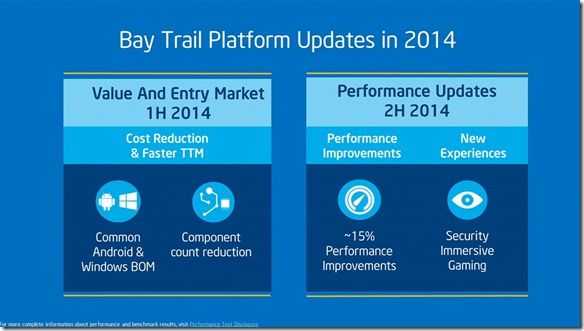We’ve been playing with the first round of Baytrail-T based Windows tablets for nearly six months now and while satisfaction levels appear to be high we’ve also realized that these ‘consumer-first’ tablets could be rounded-off with better specifications and new features that would widen their appeal to businesses and consumers. Microsoft is holding an event on the 20th May which could see a Surface Mini launch and a chance to raise the bar, raise awareness and raise excitement about Windows 8 tablets.
Small Windows tablets need leading edge design expertise and access to the latest materials, techniques and assistance from CPU manufacturers. Dell, Lenovo and others have already done a great job but Microsoft could take that further by using next generation smaller and lower-cost Intel Baytrail processors and combining them with class-leading engineering. A small boost on the CPU clock could also be on the cards along with some other features. Intel have already hinted at what’s possible in a high-end refresh.

Along with a CPU refresh we can expect some, or all of the following:
- Digitizer layer.
- 1080p screens.
- 4GB RAM.
- Larger battery.
- 3G / 4G option.
- Accessories including keyboards, cases and power.
- RealSense 3D camera technology. (See video below.)
- Biometric security (possibly related to RealSense.)
- NFC.
Microsoft have a chance to work with Intel to produce the most exciting 8-inch Windows tablet yet. Design and weight are #1 on the list. 4GB RAM, Digitizer and a fullHD screen are must-haves but If the stars align for the 20th May we could see the first RealSense-enabled product bringing advanced security, gesture control and 3D camera to the market.











All indicators point to this being another RT device so I don’t think it be anything like what you describe and it will have very little impact beyond Microsoft fans.
That would be sad. They need to showcase. RT isn’t a showcase OS yet.
I look forward to this.
Thanks Chippy.
Hoping to see a Surface Mini Pro with a Bay Trail chip. Don’t want an RT device.
I’m still finding it quite hard to see the point of an 8″ Windows device. From a productivity standpoint it’s too small to get much done, so only really works for short periods of note taking, email checking etc etc. This segment of the market is great for media / entertainment, but the Surface range isn’t focussed on this so much although I do understand that Microsoft can’t be left without an offering.
From what i’ve read, the mini will run RT and have a Qualcomm chip, so it’s not looking too high end…but perhaps this is good as it will keep the cost down and allow Microsoft to differentiate the 10″ RT with a better chip and more RAM.
Just depends what “productivity” is. Ignoring how “productivity” is defined, even at a less efficient pace, it could be the difference between getting no work done or getting something but still a useful amount done. Of course, my perspective is from a smaller device than these 8″ tablets which really can be pocketed most of the time.
By “productivity” I’m thinking of a general user, like me, wanting a balance that leans towards work more than play. It’s possible to get ‘some’ work done on an Android or iOS 8″ or 7″ device. Which leaves an 8″ Windows tablet where? There will always be a market, albeit limited, for smaller productivity tablets, but unless Microsoft launch something that’s media oriented I really don’t see it being a big seller.
With that definition of productivity then I’m going to have to agree with you. Of course, I care more about myself and certainly hope companies (often the small ones) try to create devices that meet my particular definition of productivity. I just hope they sell enough so that I can continue buying subsequent versions.
Make it a clamshell….. If it has Office it needs an attached keyboard. That would suit me. I have a Viliv N5 and use it with office but wish the screen was bigger. An 8″ screen with keyboard in a super slim form factor would be great. Not for everyone I know but I still prefer clamshell form factor for productivity.
Same here. I’m still using my N5! The physical keyboard and mouse really are more useful for what I do. I use it to SSH, RDP, VNC to remote computers. For example, I SSH into a workstation to run simulations (ModelSim, MATLAB, custom C/C++ code, etc.) or compile/synthesize code. For lighter type workloads, I actually edit and run my code locally on the N5 and just push the updates to my code repository. With a Bay Trail version, I’d probably do more local work than now.
I really wish clamshell or slider type UMPCs come back.
Oh ya, I would prefer an OQO slider form factor if I had a choice. I still miss mine ever since it suffered from accidental wife damage.
You guys are clueless thinking MS is going with x86 on this, do you still think it’s 2006? It is GUARANTEED to be based on ARM.
MS is a device company now, which means it has to make “safe” consumer-centric design decisions like Apple/Google do & leave the nerdy stuff to Dell/Lenovo among others. MS may not be there all the way yet but next year when they drop the desktop completely from small tablets they will be.
ARM was the general consensus already. Just read the comments. Plus, that’s what the rumors have been for a while. From the Surface point of view, “Pro” means x86. This isn’t labeled with the Pro term.